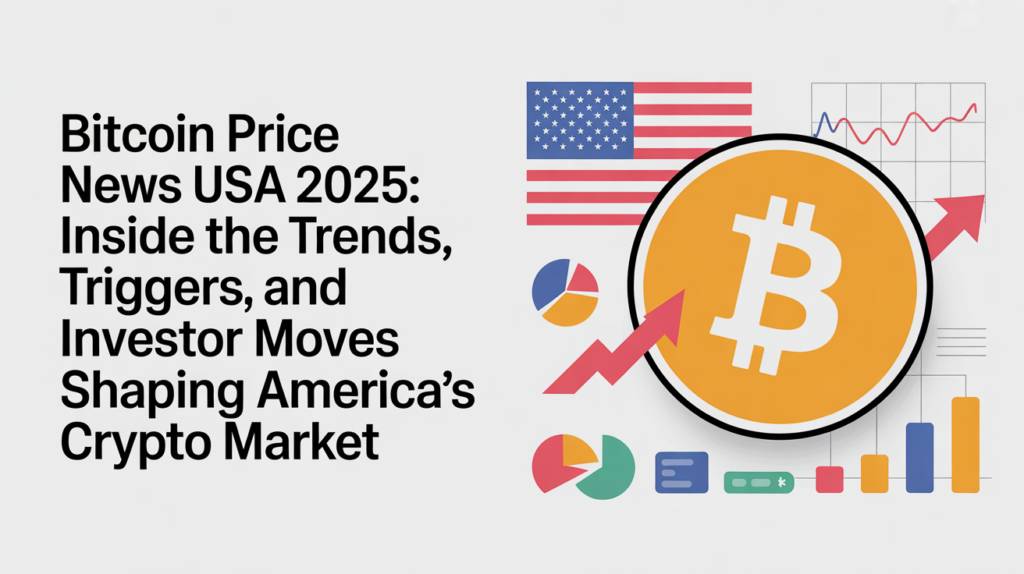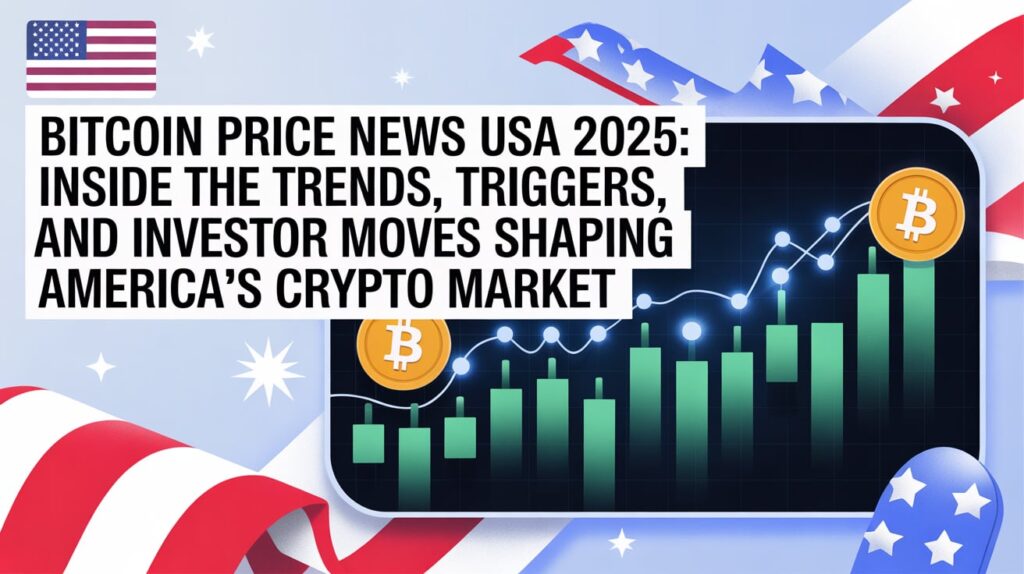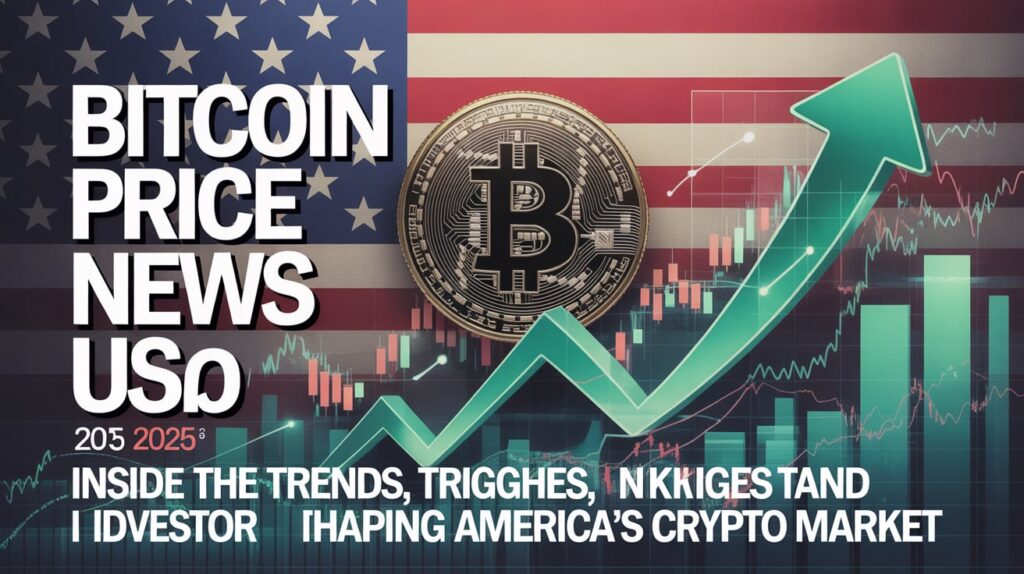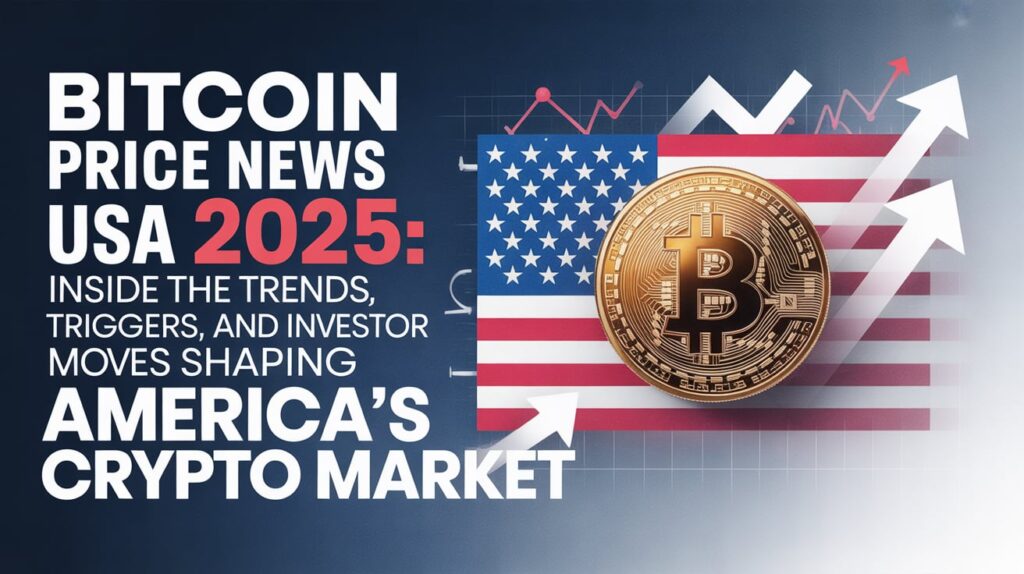🇺🇸 Bitcoin Price News USA 2025: Inside the Trends, Triggers, and Investor Moves Shaping America’s Crypto Market

📊 1. Current Bitcoin Price Overview (October 2025)
As of late October 2025:
-
BTC Price: ≈ $121 ,400 USD
-
Market Cap: $2.35 trillion
-
24-Hour Volume: $48 billion
-
Dominance: ≈ 46 % of the total crypto market
After a volatile Q1 correction, Bitcoin regained strength in Q2, boosted by ETF inflows, institutional demand, and a recovering global economy.
“Bitcoin behaves less like a speculative toy and more like a macro asset,” says Ark Invest’s Cathy Wood. “It’s now part of the American financial narrative.”
💡 2. Key Drivers Behind Bitcoin Price Movements in the USA
🔹 2.1 Institutional Adoption & Spot ETFs
The approval of Spot Bitcoin ETFs in 2024 (BlackRock, Fidelity, Vanguard) changed everything.
Billions in retirement and hedge-fund capital now flow directly into BTC, reducing volatility and legitimizing crypto as an “alternative store of value.”
🔹 2.2 Federal Reserve Policy & Inflation
When the Fed slowed rate hikes in 2025, investors pivoted from bonds to risk assets. Bitcoin, seen as “digital gold,” surged alongside tech stocks.
U.S. inflation cooling from 8 % to 3.1 % reignited confidence — but any hawkish Fed speech still causes short-term BTC swings.
🔹 2.3 Halving Momentum
The April 2024 halving cut block rewards to 3.125 BTC. Historically, halvings spark 12-18 month bull runs; 2025 is following the same path.
🔹 2.4 Corporate Treasury Adoption
Public companies like Tesla, MicroStrategy, and Square ( Block Inc. ) collectively hold > $25 billion in Bitcoin.
Corporate confidence fuels retail interest and price stability.
🏦 3. Wall Street and Bitcoin: The New Dynamic Duo
Bitcoin’s integration with traditional finance is complete. Wall Street is no longer ignoring it — it’s profiting from it.
ETF Impact
-
Over $80 billion AUM in U.S. Spot ETFs.
-
Daily trading volumes match top S&P 500 stocks.
-
ETFs bring Bitcoin to 401(k) and IRA accounts — mainstreaming ownership.
Custody & Clearing
Banks like JPMorgan and BNY Mellon offer Bitcoin custody.
Regulated clearing houses reduce counterparty risk and boost confidence for large investors.
📈 4. Retail Investors Re-Enter the Market

After the 2022 bear market, U.S. retail traders are back — smarter and more cautious.
-
Apps like Robinhood, Cash App, and Strike make BTC purchases as simple as stocks.
-
Millennials view Bitcoin as “digital retirement gold.”
-
Gen-Z embraces Lightning Network payments for everyday transactions.
Trends:
-
Recurring BTC Buys (“Stacking Sats”) via automatic investments.
-
Custody shift toward hardware wallets after exchange failures in 2022–23.
-
Crypto credit cards offering cashback in Bitcoin.
⚙️ 5. Regulatory Clarity Boosts Confidence
For the first time, U.S. regulation supports rather than stifles crypto.
The 2025 Digital Asset Framework Act:
-
Defines Bitcoin as a commodity, not a security.
-
Standardizes exchange licensing nationwide.
-
Imposes auditing rules for stablecoins.
This clarity attracts foreign investment and reduces legal uncertainty — fueling price stability.
🔋 6. Bitcoin Mining in the USA: A $10 Billion Industry
Post-China ban, the U.S. became the world’s largest Bitcoin mining hub.
Top States:
-
Texas: Cheap power + renewables.
-
Kentucky: Tax incentives for data centers.
-
North Dakota & Wyoming: Oil-field flare gas recycling into mining.
Sustainability is the keyword: 75 % of U.S. mining now runs on solar, wind, or hydro.
Mining is no longer an energy villain — it’s a grid-balancing innovation.
🧭 7. Macroeconomic Factors Shaping Bitcoin Price
-
Dollar Strength (DXY): A strong USD temporarily pressures BTC, but long-term hedge demand remains.
-
Equity Correlation: BTC tracks Nasdaq tech stocks closely ( correlation ≈ 0.62 ).
-
Gold Comparison: BTC outperformed gold by 300 % in 2025.
-
Inflation Expectations: Investors see Bitcoin as a future insurance policy against debt crises.
🧠 8. Market Sentiment & Investor Psychology
Bullish Indicators:
-
High network hash rate ( record > 600 EH/s ).
-
Rising long-term holder supply ( > 70 % of BTC untouched for 1 year ).
-
Stable ETF inflows.
Bearish Pressures:
-
Profit-taking after Q2 rally.
-
Tax season sell-offs in April.
-
Macroeconomic fears ( e.g., energy price spikes ).
Market psychology is shifting from fear and greed to strategic allocation.

💬 9. Regional Bitcoin Usage Across the USA
West Coast – The Tech Capital
San Francisco and Seattle lead developer innovation. Crypto startups collaborate with fintech giants to launch wallets and Web3 apps.
Midwest – Mining Heartland
Cheap power grids turn old factories into mining facilities. Local jobs are returning to industrial towns through Bitcoin data centers.
East Coast – Finance Meets Crypto
New York’s “Crypto Charter 2.0” allows banks to custody digital assets. Boston universities launch blockchain degree programs.
South – Everyday Adoption
Florida and Texas retailers embrace BTC for tourism and small business transactions.
🧩 10. The Rise of the Lightning Network
The Lightning Network — Bitcoin’s Layer 2 for fast transactions — has become a cornerstone of U.S. crypto payments.
-
8 million active Lightning wallets.
-
Processing ≈ 6 million transactions daily.
-
Average fee < 0.01 USD per transaction.
This infrastructure makes Bitcoin usable for daily purchases — from coffee to concert tickets.
💵 11. Corporate Integration & Merchant Adoption
-
Starbucks, AMC, and Subway accept BTC via Lightning POS.
-
Shopify merchants enable crypto checkouts.
-
PayPal & Visa settle BTC transactions on-chain through partnerships with BitGo and Fireblocks.
Small businesses now see BTC as a marketing edge and a hedge against dollar inflation.
⚖️ 12. Taxation and Compliance in the U.S.
-
Short-term trades taxed as income.
-
Long-term holding > 12 months taxed as capital gains.
-
New threshold: transactions under $200 per day are tax-exempt.
IRS integration with major exchanges simplifies filing but demands transparency. Accountants are now adding “crypto tax specialist” to their titles.
🪙 13. Altcoins vs Bitcoin — The Market Showdown
Ethereum and Solana grow, but Bitcoin remains the liquidity anchor.
Institutions favor BTC for regulatory clarity and liquidity depth.
Altcoin cycles add volatility, but Bitcoin dominance is rising again as investors seek safety amid AI-token hype.
🧾 14. Future Price Predictions

Bullish Scenario ( 2026 – 2030 )
-
Bitcoin > $250 ,000 by 2027.
-
Global market cap ≈ $5 trillion.
-
Lightning Network replaces Visa for micro-payments.
Bearish Scenario
-
Regulatory uncertainty returns after election cycles.
-
Liquidity shifts to stablecoins and AI projects.
Even so, BTC’s floor price remains strong near $80 ,000 due to institutional holding.
🌍 15. Bitcoin and America’s Role in Global Adoption
The U.S. remains the world’s largest Bitcoin market by volume and infrastructure.
American policy and innovation will decide whether Bitcoin becomes a parallel financial standard or just an asset class.
Emerging markets look to Washington for regulatory leadership. If the U.S. embraces Bitcoin fully, the rest of the world will follow.
💬 Conclusion: The American Crypto Moment
Bitcoin’s journey in the United States reflects a larger shift — from distrust to integration, from experiment to institution.
In 2025, it isn’t “if” America adopts Bitcoin — it’s how deeply it will embed it into its financial DNA.
Bitcoin isn’t a trend in the U.S. anymore. It’s a movement — and the movement has momentum.
As the digital dollar debate and global inflation continue, Bitcoin remains the people’s currency — transparent, borderless, and unstoppable.
The price may rise and fall, but the adoption curve is set in stone. America is not watching the crypto revolution — it’s leading it.